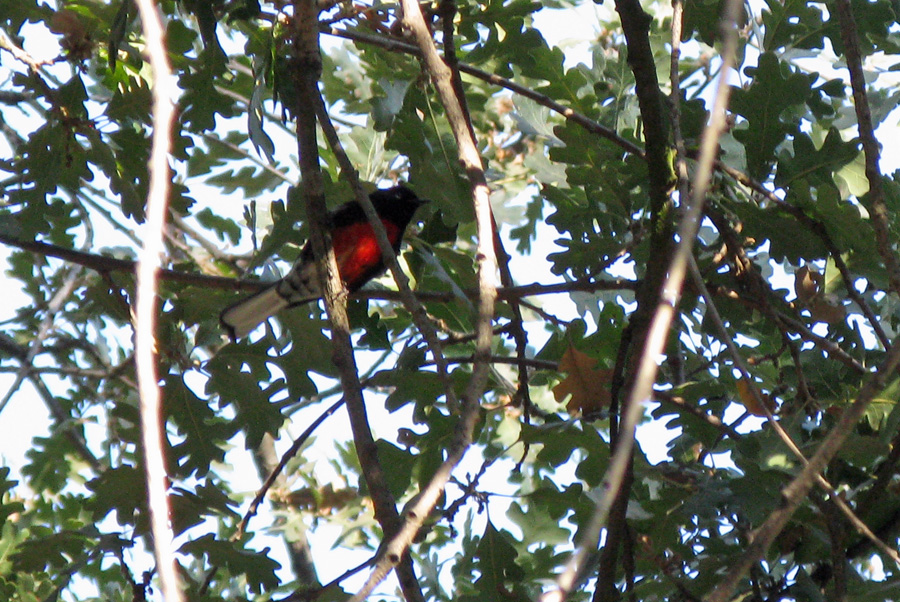#447 and #448 at Bonelli Park
I haven’t done a lot of rarity chasing this year. Coming from Brooklyn, there’s not a lot of excitement in finding a Yellow-breasted Sapsucker, an American Redstart, or an American Tree Sparrow, all of which are common park birds back east. Instead I’ve been focusing on local western birds that are still lifers for me such as Black Turnstone and Surfbird. However when I heard about a Painted Redstart over in Bonelli Regional Park, that seemed worth chasing. It’s a common southern Arizona bird, but doesn’t show up much elsewhere. However this one seems to be pretty reliable, and it’s less than an hour away from Irvine.
I got to the park about 8:30 this morning, and after getting a little lost–I think I was driving down a horse trail–I eventually located the correct parking lot. I luckily stumbled on the monthly bird walk at Bonelli park, and they helpfully pointed me to the correct tree in which to look. They’d already seen the Redstart. I drove to the other end of the parking lot, and scanned the tree. House Finches were singing noisily, but no Redstart. I walked across the road and picked up Hutton’s Vireo, and then came back to the Oak. About 10 minutes later, the redstart flies in with a quick “Che-wee. Che-wee”.
I got a brief look at it, before it disappeared again into the middle of the foliage. It’s a striking and unmistakeable bird though. Then, about a minute later, it burst out again with a lot more calling and activity, and I was able to grab some pictures and study it a bit.

(By the way, if anyone else wants to chase it, immediately after entering the park turn left into the first parking lot; park in front of restroom #8; stand in the leftmost handicapped parking space, and look across the lot at the two oak trees. The bird has also been seen outside restroom #11. )
The Redstart flew away after about ten minutes, so I walked down to the other end of the parking lot and caught up with the monthly group. They had a tree full of Bushtits and were trying to spot a calling Mountain Chickadee. We found it. I’ve had a lot of Black-capped, Carolina, and Chestnut-backed Chickadees every year since I started birding, but this was my first Mountain Chickadee since my first trip to Orange County back in 2005.
From there we walked back to the cars and added White-crowned Sparrow, Western Scrub Jay, and a flyover Double-crested Cormorant to the list. Then we drove to the East Shore of the lake. An Osprey was perched in plain view. The lake was full of American Coots, Mallards, American Wigeons, one Ring-necked Duck and two Redheads:
We also had several California Gulls and five Grebe species: Western, Clark’s, Pied-billed, Eared, and Horned. The brush along the road produced California Thrasher, Northern Mockingbird, Greater Roadrunner, more Bushtits and Chickadees, Orange-crowned Warbler, Song Sparrow, White-crowned Sparrow, and probably a few I’m forgetting. There were also a couple each of Great Egret, Snowy Egret, and Great Blue Heron fishing around the lake.
Walkingt back to the parking lot (the whole hike wasn’t but barely a mile) we added Lesser Goldfinch and Cassin’s Kingbird. However the piece de resistance was the last bird of the day, one very well camouflaged Barn Owl in a pine tree:

This was completely unexpected (by me; the leader knew it was there) and my second life bird of the day. I could actually have found Barn Owl in New York, but somehow I never did. (The only reliable sites for Barn Owl in New York require a boat to access. Plus you really don’t want to disturb nesting owls without a better reason than a list.)
Total species count for the park was 48, and I may have missed one or two:
- Gadwall
- Mallard
- Northern Shoveler
- Redhead
- Ring-necked Duck
- Ruddy Duck
- Graylag Goose (Domestic type)
- Pied-billed Grebe
- Great Egret
- Osprey
- Black Phoebe
- Barn Owl
- Greater Roadrunner
- California Gull
- Spotted Sandpiper
- Killdeer
- American Coot
- Red-tailed Hawk
- Northern Harrier
- Song Sparrow
- California Towhee
- Belted Kingfisher
- Common Yellowthroat
- Yellow-rumped Warbler
- Orange-crowned Warbler
- California Thrasher
- Northern Mockingbird
- Cactus Wren
- Cassin’s Kingbird
- Lesser Goldfinch
- Snowy Egret
- Great Blue Heron
- Horned Grebe
- Eared Grebe
- Western Grebe
- Clark’s Grebe
- Double-crested Cormorant
- Anna’s Hummingbird
- House Finch
- White-crowned Sparrow
- Spotted Towhee
- Painted Redstart
- Ruby-crowned Kinglet
- Bewick’s Wren
- Hutton’s Vireo
- Western Scrub-Jay
- Mountain Chickadee
- Bushtit
Also, with these two life birds, California has now pulled ahead of New York in my lists: 247 to 245, though I know the New York list is missing at least a couple (definitely Least Bittern and Summer Tanager, and probably some others.) because I didn’t keep such good records when I was just starting out. Orange County is still way out in front county-wise, but Los Angeles has now jumped to the middle of the pack, just ahead of Sussex in New Jersey and just behind San Francisco.
